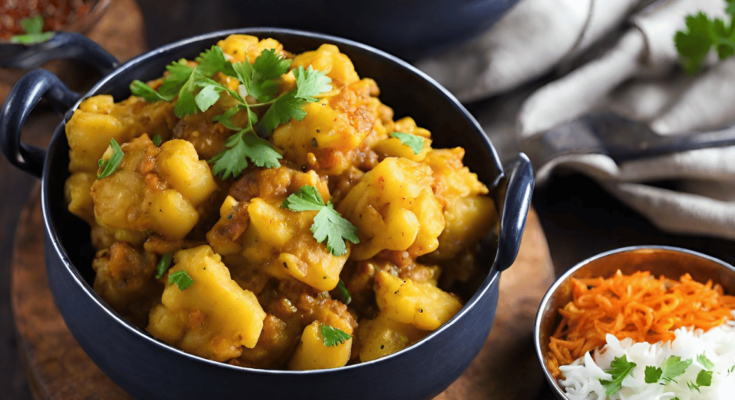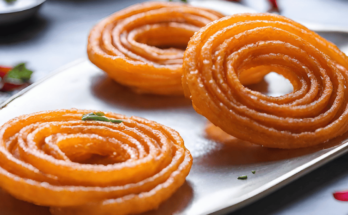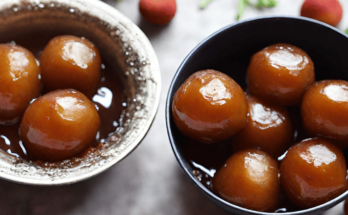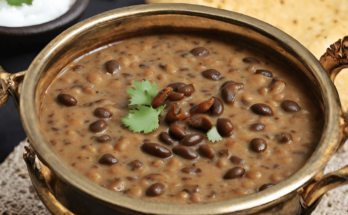Aloo Gobi, with its comforting blend of potatoes and cauliflower, is a beloved dish that holds a special place in Indian cuisine. In this comprehensive guide, we’ll explore the origins of Aloo Gobi, uncover its secrets, and learn how to prepare this flavorful delicacy in your own kitchen.
Origin and History of Aloo Gobi
Aloo Gobi traces its roots to the Indian subcontinent, where it has been enjoyed for centuries as a staple dish in households across the region. The name “Aloo Gobi” is derived from Hindi, with “aloo” meaning potatoes and “gobi” meaning cauliflower.
Cultural Significance of Aloo Gobi in Indian Cuisine
Aloo Gobi is more than just a dish; it’s a symbol of comfort, warmth, and hospitality in Indian culture. Often served as a main course or side dish, Aloo Gobi is enjoyed by people of all ages and backgrounds, making it a timeless classic in Indian cuisine.
Ingredients and Preparation
Essential Ingredients for Aloo Gobi
- The key ingredients for Aloo Gobi include potatoes, cauliflower, onions, tomatoes, ginger, garlic, and a blend of spices such as turmeric, cumin, coriander, and garam masala. Each ingredient contributes its unique flavor and texture to the dish, resulting in a harmonious blend of flavors.
Preparing the Potatoes and Cauliflower
- Before cooking, peel and dice the potatoes into bite-sized pieces and separate the cauliflower into florets. Rinse the vegetables thoroughly under cold water to remove any dirt or debris, then pat them dry with a clean kitchen towel.
Cooking Methods
Step 1: Stovetop Cooking
To prepare Aloo Gobi on the stovetop, heat oil in a large skillet or wok over medium heat. Add the diced potatoes and cauliflower florets, along with chopped onions, ginger, and garlic. Sauté until the vegetables are tender and lightly browned, stirring occasionally to prevent sticking.
Step 2: Pressure Cooker Method
For a quicker cooking time, you can use a pressure cooker to make Aloo Gobi. Simply follow the same steps as for stovetop cooking, but cook the vegetables under pressure for about 3-4 whistles, or until they are soft and cooked through.
Step 3: Oven Roasting
For a hands-off approach, you can roast the Aloo Gobi in the oven for a deliciously caramelized flavor. Preheat your oven to 425°F (220°C), spread the vegetables on a baking sheet in a single layer, and roast for 25-30 minutes, or until golden brown and tender.
Flavor Profile and Seasonings
Key Spices for Aloo Gobi
- The signature flavor of this recipe comes from a blend of spices, including turmeric, cumin, coriander, and garam masala. These spices not only add warmth and depth to the dish but also provide numerous health benefits.
Adjusting Spice Levels to Taste
- Feel free to adjust the amount of spices according to your taste preferences. If you prefer a milder flavor, reduce the amount of chili powder or omit it altogether. For an extra kick, add a pinch of cayenne pepper or chopped green chilies.
Serving Suggestions
Accompaniments and Side Dishes
- Aloo Gobi pairs well with a variety of Indian breads such as naan, roti, or paratha. It can also be served alongside steamed rice or as part of a larger Indian meal with dishes like dal, raita, and chutney.
Garnishes and Presentation Ideas
- Garnish your dish with fresh cilantro leaves, thinly sliced green chilies, or a squeeze of lemon juice for a burst of freshness and flavor. Serve it in a decorative serving dish or traditional Indian thali for an authentic touch.
Variations and Adaptations
Regional Variations Across India
- In addition to the classic Aloo Gobi recipe, there are numerous regional variations of this dish found across India. Some versions may include additional ingredients such as peas, bell peppers, or even paneer for added flavor and texture.
Vegetarian and Vegan Alternatives
- This dish is naturally vegetarian and can easily be made vegan by omitting any dairy products such as ghee or yogurt. Substitute vegetable oil for ghee and use dairy-free yogurt or coconut milk to achieve a creamy texture without compromising on flavor.
Health Benefits
Nutritional Profile of Aloo Gobi
- Aloo Gobi is not only delicious but also packed with essential nutrients. Potatoes provide carbohydrates for energy, while cauliflower is rich in fiber, vitamins, and antioxidants. The spices used in Aloo Gobi also offer numerous health benefits, including anti-inflammatory and digestive properties.
Potential Health Benefits of Ingredients
- Turmeric, a key ingredient in this recipe, contains curcumin, a compound with powerful antioxidant and anti-inflammatory effects. Cumin and coriander are known for their digestive benefits, while garlic and ginger have antibacterial and immune-boosting properties.
Tips for Success
Achieving the Perfect Texture
- To ensure that your recipe has the perfect texture, be careful not to overcook or undercook the vegetables. Cook them just until they are tender but still retain some bite, as overcooking can result in mushy vegetables.
Preventing Overcooking or Undercooking
- To prevent the vegetables from overcooking, add them to the pan in stages, starting with the potatoes, which take longer to cook, and adding the cauliflower later. Alternatively, you can blanch the cauliflower in boiling water for a few minutes before adding it to the pan.
READ MORE: https://recipereverie.com/tandoori-chicken/
Aloo Gobi in Popular Culture
References in Movies, Literature, and Music
- Aloo Gobi has made appearances in various forms of popular culture, from Bollywood movies to international literature and music, where it is often depicted as a symbol of home-cooked comfort food and family gatherings.
Celebrity Endorsements and Recipes
- Many celebrities and chefs have endorsed this recipe as one of their favorite dishes, sharing their own recipes and adaptations with fans and followers around the world. Its simple yet satisfying flavor makes it a favorite among food enthusiasts of all ages.
Conclusion
In conclusion, Aloo Gobi is more than just a dish; it’s a culinary journey through the vibrant flavors and traditions of Indian cuisine. By following this guide, you can recreate the magic of Aloo Gobi in your own kitchen, bringing warmth, comfort, and deliciousness to your table.
So why not give it a try? With its simple ingredients, easy preparation, and irresistible flavor, Aloo Gobi is sure to become a staple in your repertoire of home-cooked meals. So go ahead, grab some potatoes and cauliflower, and get ready to embark on a culinary adventure like no other.
Possible FAQs About this Recipe
1. Can I use frozen cauliflower for Aloo Gobi?
- Yes, you can use frozen cauliflower as a convenient alternative to fresh cauliflower. However, keep in mind that frozen cauliflower may release more moisture during cooking, so adjust the cooking time accordingly to prevent the dish from becoming too watery.
2. How do I prevent the potatoes from getting mushy?
- To prevent the potatoes from becoming mushy, be sure to dice them into uniform-sized pieces and avoid overcooking. Cook the potatoes just until they are tender but still firm to the bite, as they will continue to cook slightly after being removed from the heat.
3. Can I make Aloo Gobi ahead of time?
- Yes, Aloo Gobi can be made ahead of time and reheated before serving. Simply allow the dish to cool completely, then transfer it to an airtight container and refrigerate for up to 2-3 days. Reheat gently on the stovetop or in the microwave until heated through.
4. Can I add other vegetables to Aloo Gobi?
- Yes, Aloo Gobi can be customized with additional vegetables according to your preference. Common additions include peas, carrots, bell peppers, or even spinach. Just be mindful of the cooking times for each vegetable and adjust accordingly.
5. Is Aloo Gobi gluten-free?
- Yes, Aloo Gobi is naturally gluten-free, as it does not contain any wheat or gluten-containing ingredients. However, if you’re using store-bought spice blends or other packaged ingredients, be sure to check the labels for any hidden gluten.
6. Can I make Aloo Gobi without onions and garlic?
- Yes, you can omit onions and garlic from the recipe if you prefer or if you have dietary restrictions. Simply skip these ingredients and adjust the seasoning to taste with other spices such as ginger, cumin, or coriander.
7. How do I store leftovers of Aloo Gobi?
- Leftover Aloo Gobi can be stored in an airtight container in the refrigerator for up to 2-3 days. For longer storage, you can freeze the dish in a freezer-safe container for up to 1-2 months. Thaw overnight in the refrigerator before reheating.
8. Can I make Aloo Gobi without oil?
- Yes, you can make a oil-free version of Aloo Gobi by using alternative cooking methods such as steaming or baking. Simply toss the vegetables with your desired spices and roast them in the oven or steam them until tender. Alternatively, you can use a non-stick skillet or cookware to sauté the vegetables without oil.
9. Can I use sweet potatoes instead of regular potatoes?
- Yes, you can substitute sweet potatoes for regular potatoes in Aloo Gobi for a slightly sweeter flavor. Keep in mind that sweet potatoes may require a shorter cooking time than regular potatoes, so adjust the cooking time accordingly to prevent them from becoming too soft.
10. Can I make Aloo Gobi spicy?
- Yes, you can adjust the level of spice in Aloo Gobi according to your taste preferences. Add more chili powder, green chilies, or red pepper flakes for extra heat, or reduce the amount of spice for a milder flavor. Experiment with different combinations of spices until you find the perfect balance of flavors.





One Comment on “Quick Aloo Gobi Recipe | Flavorful & Easy to Make”